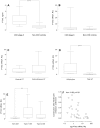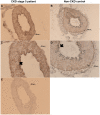Elevated circulating levels and tissue expression of pentraxin 3 in uremia: a reflection of endothelial dysfunction
- PMID: 23658833
- PMCID: PMC3643920
- DOI: 10.1371/journal.pone.0063493
Elevated circulating levels and tissue expression of pentraxin 3 in uremia: a reflection of endothelial dysfunction
Abstract
Elevated systemic pentraxin 3 (PTX3) levels appear to be a powerful marker of inflammatory status and a superior outcome predictor in patients with chronic kidney disease (CKD). As previous data imply that PTX3 is involved in vascular pathology and that adipose tissue mass may influence circulating PTX3 levels, we aimed to study the importance of adipose tissue expression of PTX3 in the uremic milieu and its relation to endothelial dysfunction parameters. Plasma PTX3 and abdominal subcutaneous adipose tissue (SAT) PTX3 mRNA levels were quantified in 56 stage 5 CKD patients (median age 57 [range 25-75] years, 30 males) and 40 age and gender matched controls (median age 58 [range 20-79] years, 27 males). Associations between PTX3 measures and an extensive panel of clinical parameters, including surrogate markers of endothelial function, were assessed. Functional ex vivo studies on endothelial status and immunohistochemical staining for PTX3 were conducted in resistance subcutaneous arteries isolated from SAT. SAT PTX3 mRNA expression correlated with plasma PTX3 concentrations (rho = 0.54, p = 0.0001) and was increased (3.7 [0.4-70.3] vs. 1.2 [0.2-49.3] RQ, p = 0.02) in CKD patients with cardiovascular disease (CVD), but was not significantly different between patients and controls. The association to CVD was lost after adjustments. SAT PTX3 mRNA levels were independently correlated to asymmetric dimethylarginine and basal resistance artery tone developed after inhibition with nitric oxide synthase and cyclooxygenase (rho = -0.58, p = 0.002). Apparent positive PTX3 immunoreactivity was observed in both patient and control arteries. In conclusion, fat PTX3 mRNA levels are associated with measures of endothelial cell function in patients with CKD. PTX3 may be involved in adipose tissue-orchestrated mechanisms that are restricted to the uremic milieu and modify inflammation and vascular complications in CKD patients.
Conflict of interest statement
Figures



Similar articles
-
Associations of plasma pentraxin 3 and monocyte chemoattractant protein-1 concentrations with cardiovascular disease in patients with chronic kidney disease.Ren Fail. 2011;33(4):398-404. doi: 10.3109/0886022X.2011.568136. Ren Fail. 2011. PMID: 21529268
-
Association between levels of pentraxin 3 and incidence of chronic kidney disease in the elderly.J Intern Med. 2016 Feb;279(2):173-9. doi: 10.1111/joim.12411. Epub 2015 Sep 9. J Intern Med. 2016. PMID: 26355706 Free PMC article.
-
Expression of long pentraxin PTX3 in human adipose tissue and its relation with cardiovascular risk factors.Atherosclerosis. 2009 Feb;202(2):455-60. doi: 10.1016/j.atherosclerosis.2008.05.015. Epub 2008 May 15. Atherosclerosis. 2009. PMID: 18571180
-
Pentraxin-3 and endothelial dysfunction.Adv Clin Chem. 2019;91:163-179. doi: 10.1016/bs.acc.2019.03.005. Epub 2019 May 4. Adv Clin Chem. 2019. PMID: 31331488 Review.
-
Long pentraxin 3: experimental and clinical relevance in cardiovascular diseases.Mediators Inflamm. 2013;2013:725102. doi: 10.1155/2013/725102. Epub 2013 Apr 7. Mediators Inflamm. 2013. PMID: 23690668 Free PMC article. Review.
Cited by
-
Investigation of the Mechanism Underlying Calcium Dobesilate-Mediated Improvement of Endothelial Dysfunction and Inflammation Caused by High Glucose.Mediators Inflamm. 2019 Oct 21;2019:9893682. doi: 10.1155/2019/9893682. eCollection 2019. Mediators Inflamm. 2019. PMID: 31780874 Free PMC article.
-
Hemodialysis Induces an Acute Decline in Cerebral Blood Flow in Elderly Patients.J Am Soc Nephrol. 2018 Apr;29(4):1317-1325. doi: 10.1681/ASN.2017101088. Epub 2018 Mar 1. J Am Soc Nephrol. 2018. PMID: 29496888 Free PMC article.
-
Novel association between serum pentraxin-2 levels and advanced fibrosis in well-characterised patients with non-alcoholic fatty liver disease.Aliment Pharmacol Ther. 2015 Sep;42(5):582-90. doi: 10.1111/apt.13292. Epub 2015 Jun 29. Aliment Pharmacol Ther. 2015. PMID: 26119353 Free PMC article.
-
Evaluation of the association of plasma pentraxin 3 levels with type 2 diabetes and diabetic nephropathy in a Malay population.J Diabetes Res. 2013;2013:298019. doi: 10.1155/2013/298019. Epub 2013 Nov 20. J Diabetes Res. 2013. PMID: 24350299 Free PMC article.
-
PTX3 in serum induces renal mesangial cell proliferation but has no effect on apoptosis.Exp Ther Med. 2018 Feb;15(2):1193-1198. doi: 10.3892/etm.2017.5521. Epub 2017 Nov 16. Exp Ther Med. 2018. PMID: 29434706 Free PMC article.
References
Publication types
MeSH terms
Substances
LinkOut - more resources
Full Text Sources
Other Literature Sources
Medical
Research Materials
Miscellaneous

